Midges, Mosquitoes and Ponds
Bothersome flying insects are often blamed on ponds. In particular, midges and mosquitoes annoy people, plague livestock or wildlife and can transmit diseases. Landowners, in their haste to reduce the problem, may make unwise pond management choices. One of the underappreciated benefits of these insects is they are a major food source for fish. This Fact Sheet details reasonable steps to reduce midge and mosquito problems.
Midge is the common name given for a large number of tiny flying insects. Some species bite, while others do not. They are small, but if you were to look at one up close, it would resemble a slender mosquito. Midges lay their eggs on water, where they typically take four weeks to develop into a flying adult (Figures 1 and 2). Another insect commonly in this system are ‘no-see-ums,’ which are biting midges (Culicoides). These biting midges feed on a wide variety of animals and lay their eggs in muddy areas in pasture systems, normally around water trough areas, swampy riverine areas or even in the mud at the edge of ponds.
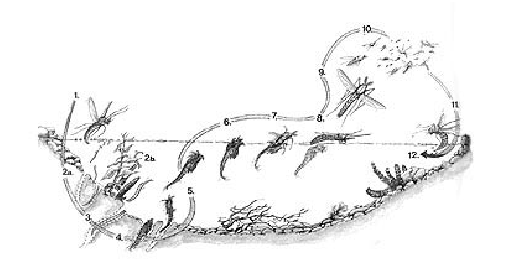
Figure 1. The midge life lifecycle from egg laying adult to larva to pupa to emerging adult. Credit: unclebillys.com.au
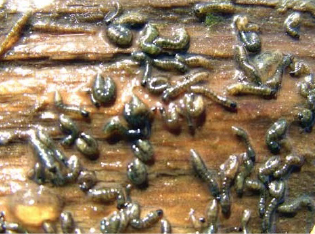
Figure 2. Disgusting or delicious? These midge larvae on the underside of some submerged wood will be relished by bluegill and other sunfish. The pupae that emerge from them will also be an important food for young largemouth bass and other game fish. Credit: miniturnanglers.com
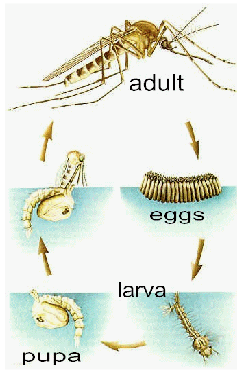
Figure 3. The mosquito lifecycle takes place mostly in water. The larvae and pupae are highly vulnerable to being eaten by many different species of fish. Credit: Cornell University
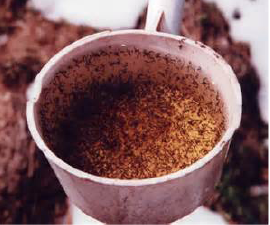
Figure 4. Any puddle or small amount of water will do. Birdbaths, clogged rain gutters, old tires, trash piles etc. are major breeding grounds for midges and mosquitoes. Responsible home- and landowners will take steps to eliminate or manage such items to prevent them from creating a problem. Credit: www.plymouthmosquito.org
Diseases Associated with Biting Midges and Mosquitoes
Bluetongue or Epizootic Hemorrhagic Disease (EHD). The disease is transmitted by biting midges of the family, Culicoides. Mortality among infected deer generally is less than 25 percent but can be 50 percent or more. Bluetongue can also lead to high mortality in domestic sheep populations. Sick deer suffering from Bluetongue or EHD diseases often move to the vicinity of ponds or other water sources to cool down from their high fevers.
West Nile Virus is primarily a disease of birds and is incidentally spread to humans and horses by mosquitoes that have fed on infected birds. Symptoms typically develop within two to 14 days after being bitten. The effects can be mild or severe (severe headaches, a stiff neck, disorientation or confusion) requiring immediate medical attention.
Zika Virus is an emerging, mosquito transmitted disease that might become a problem in the continental U.S. Seek advice from health officials as new information develops.
Action
Pond owners can reduce the number of flying midges and mosquitoes by ensuring that ponds are stocked with insect-eating fish species. They are likely already in the pond. Common pond fish such as bluegill and related sunfish, often known as “perch,” are already in most Oklahoma ponds and do an excellent job of insect control. Likewise goldfish or koi carp are already present in almost every water garden.
There is generally no need to stock Gambusia affinis (mosquitofish) (Figure 5) for the control of midges and mosquitoes. In fact, Gambusia are harmful to desirable fish species in ponds and elsewhere. Adult mosquitofish are aggressive consumers of the fry and young of bass, bluegill and other game fish. Stocking mosquitofish is a poor idea especially when bluegill and similar game fish are present and able to consume and control the young aquatic forms of midges and mosquitoes.
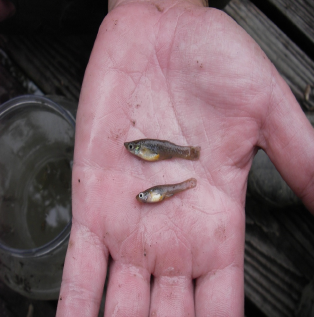
Figure 5. Mosquitofish (Gambusia affinis) harm the quality of fishing in ponds by eating the young of other fish and reducing that amount of food available to desirable game fish. Bluegill and other commonly stocked pond fish are likely to already be present in most ponds and doing a great job of reducing or eliminating the larvae and pupae of midges and mosquitoes. Credit: Indianapublicmedia.org
For personal protection in a given location, prevention of flying insect bites is recommended though use of insect repellents and clothing that covers the body. If you also believe a pond is a breeding ground for these problem insects, seek advice from public health officials.
The following steps are recommended for eliminating or managing prime breeding areas for midges and mosquitoes:
- Dispose of anything outside that can hold water such as broken toys, tin cans, containers, ceramic pots, and in particular, used tires, which are a major problem due to their abundance.
- Drill holes in the bottoms of recycling containers left outdoors.
- Clean clogged roof gutters every year, especially if leaves tend to plug the drains.
- Turn over plastic swimming/wading pools and wheelbarrows when not in use.
- Do not allow water to stagnate in birdbaths, ornamental pools, water gardens and swimming pools or their covers. Ornamental pools should be stocked with fish, and swimming pools should be cleaned and chlorinated when not in use.
- Empty accumulated water from boats and cargo trailers.
- Alter the landscape of your property to eliminate standing water. Keep in mind that during warm weather, midges and mosquitoes can breed in any puddle of water.
- Be aware of areas that maintain wetness over a period of time such as water springs in wooded areas and/or next to pastures, water feeding systems for livestock in a pasture or even receding ponds. These may serve as sites for the development of biting midges.
- Check human and animal waste lagoons for midge and mosquito larvae. They may be able to reproduce more successfully in waste lagoons because fish are absent. If you find large numbers, seek advice from public health officials.
- If drought becomes a problem and the pond tends to dry up but is still muddy, then apply a granular larvicide to control biting midges that can transmit bluetongue or EHD.
Conclusion
It is wise to eliminate small puddles and pockets of water because they are major breeding areas for midges and mosquitoes. But when tempted to eliminate midges, mosquitoes or other insects in ponds, remember that the fish in the pond will starve. Ponds are unlikely to be the major source of the adult midges and mosquitoes annoying you, your livestock and wildlife. In matters of animal and human health, always seek advice from veterinarians, physicians, public health officials or medical entomologists rather than rely on often inaccurate news stories, the internet or local opinions.
Marley Beem
Assistant Extension Specialist, Natural Resource Ecology and Management
